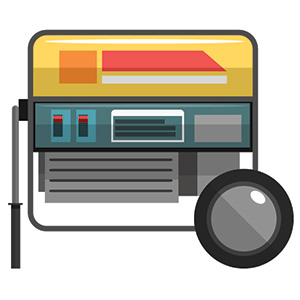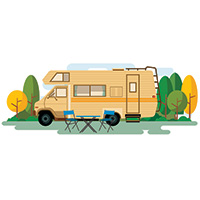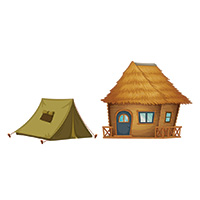The first question you will probably ask yourself before buying a generator is, “What size generator do I need?” Whether you live in an area that often has storms and occasional power outages, or you want to make sure that your day-to-day life can run as usual even during blackouts, a generator is a good choice. We can do very few things without electricity today. Generators come in handy when you need a source of backup power that you can rely on to save the day.
Unfortunately, there is no one answer to this question. There are many variables when it comes to choosing the right size generator. However, in this comprehensive guide, we will cover all the details to help you make a proper decision. Although the following generator sizing guide will give you some idea about the average size range. That said, no online manual is a substitute for a licensed electrician who can accurately calculate your electrical load requirements.

Generator Sizing 101
What size generator you need is determined by many factors, including the size of your space, the type of fuel incorporated, and of course, the load requirements of your electric appliances. At the same time, take into consideration some extra load growth. There are some steps that you should consider when it comes to choosing the proper generator size.
- So, the first step is deciding what you are going to use the generator for. You can choose to use it for your home needs, business, RV, camping, or even outdoor events.
- The next step is to make a list of what exactly you want to power and when.
- The third step is to determine the running and surge wattage of everything you want to power with the generator.
- Finally, the total addition of the watts will tell you the minimum output required from your generator. (You can also add to the total wattage 25% more to anticipate future needs).
Of course, it would be lovely if the process is more simple than that, but there is a bit more to it. So, instead of jumping into making decisions, keep reading to find out absolutely everything necessary.
Explaining the Steps
Before we get into why the above steps should be taken with a grain of salt, let’s first clear some things up.
Why Should You Choose What You Will Power and When?

Every appliance or device has a specific wattage (e.g., a dishwasher has a running wattage of 1200). This number is what you need to know to calculate the minimum size of the generator.
When you will power these household appliances is also essential. You can calculate the total wattage of every appliance/device you have. But the fact is that your coffee maker, refrigerator, sump pump, and air conditioning unit are not going to work simultaneously. So, if you add the total wattage up, you may end up with a much larger generator than you actually need.
Instead, when the sump pump is off, something else can be powered. For example, turn the coffee maker off when you use the washing machine. This way, you will be able to avoid paying extra money for a large generator that you may not actually use to its full potential.
We prepared this appliance wattage chart to help you calculate the power consumption of all your machines, tools, and devices.
What are the Running Watts and Starting Watts of Appliances?
These are also important for calculating the generator size. Running wattage is what an appliance/device needs to work. However, some appliances also have a starting wattage, which is the amount of power they need to start up their internal motor. Surge watts don’t apply to all applications; some devices require the same wattage to start and continue working. While other applications will require extra wattage when starting, mainly applications that have an electric motor.
For example, a computer has a running wattage of 600 watts, but it does not need any additional power to start. However, a house fan needs 600 watts to start and only 300 watts to keep running. Think of the surge watts as extra energy for the appliance to begin operating. This additional energy is only required momentarily, and then it goes down to lower stable running watts.
So, this is important because you need to consider that the fan will initially pull 600 watts to start working. But then it will require only 300 watts to continue. And the other 300 watts can go into powering something else. As a result, the initial starting wattage must be taken into consideration in your generator sizing process. Primarily, that starting watts can sometimes be two or three times more than the running watts.
What are the Maximum Watts and Rated Watts of Generators?

Generators also have surge and running watts. Usually, you will find manufacturers advertising for their new models with the maximum/surge watts. To learn more, let’s explain what these outputs are.
Surge watts for generators represent the maximum power output they can produce. However, this power is limited, and it can last for a maximum of 30 minutes. This additional power limit is useful for the extra wattage needed to start up a machine or a device. And as we explained in the above section that appliances require this extra starting energy only momentarily.
On the other hand, rated watts for generators represent the continuous power output they can produce. Usually, the rated watts are 80-90% of the maximum watts. You should always build your sizing calculations on the rated watts of a generator to get adequate continuous power for your needs.
How to Find Information about the Surge and Running Wattage?
The wattage information is usually written somewhere on the device or in the user manual. Remember that sometimes only one number represents both wattages, or there is simply no surge wattage for the device. If there is no information about wattage, it is enough if you find information about the amps, then you can calculate the running wattage requirements with the following formula:
Watts = Amps x Volts
Amps = Watts / Volts
Volts = Watts / Amps
The voltage differs depending on where you live, but it is typically 120 volts in the US. If you have any of the two numbers, you can find out the third with these formulas.
It’s also important to note that most electrical motors will need additional surge/starting wattage, up to three times its running wattage. Also, old machines tend to use more than the indicated power as they become less efficient over time. Remember, you can also use an appliance load tester to determine the exact rated watts needed for each application.
How Big of a Generator Do I Need?
Since there are a lot of variables, we understand that determining a generator size can be difficult. But there is one recommendation that can help you. After you determine the running wattage for all the selected appliances you plan to use, add them up and add the highest surge wattage for the highest appliance/device that draws the most power. We do this to ensure that the generator has enough power to start up even the largest appliance/device of them all. This is how you determine the average generator size you need, and you should definitely not go below it.
If you schedule the use of your devices well, you can get by with the minimum need. But, if your budget allows you, it would not be a bad idea to go a bit beyond the minimum. This way, you can be more relaxed about seasonal loads or other extra device usages.
We have this in-depth article that explains the average cost of generators, which can help you to decide according to your budget.
Average Generator Size
First, we have inverter generators. They range from 1,000 watts and up to 7,000 watts, and this range is usually enough to power most essential appliances in a power outage. Portable inverter generators have the advantage of being quieter, more compact, and also some models can be paralleled with other inverter generators to achieve more power output.
Next, we have portable generators. They range from 1,000 watts and up to 15,000 watts. Portable generators are the most popular, and they are widely used in many situations. Portable generators have the advantage of being more budget-friendly than other types and offer more wattage flexibility.
Lastly, we have home standby generators. They range from 5,000 watts and up to 50,000 watts. They provide enough power for an entire home, industrial/commercial businesses, and in places prone to frequent power outages. Standby home generators have the advantage of being able to supply uninterrupted power for extended periods during a power outage. A home standby generator is connected to a natural gas line and can power many applications.
What Size Generator Do I Need?
Now that we cleared all the questions regarding these basic steps. Let’s look into what your options are in some specific situations. Here is an average power estimate to answer “what size generator do I need?“
Household & Cabins

What generator you will choose for your home depends on two factors. The first is what you want to power during a power outage, and the second is how often you will use it.
If your home experiences power outages once or twice a year, you may not want to spend a lot of money on a home standby generator, but you still would like to be sure that the essentials will work. In this case, you can estimate an average of 3000 and 7500 watts. Or, if your home relies on large electrical heating, central air conditioners, etc., an average of 5000 and 10,000 watts should do.
If, on the other hand, you experience power outages more frequently, or you want everything to work all the time, then definitely choosing a standby generator will satisfy all your needs. An average wattage used in large households can go up towards 7000 and 20000 watts. All are broad estimates, but if you follow our step-by-step guide, you will be able to find the exact size you need.
RVs & Boats

When it comes to powering appliances/devices in your RV or boat, the process of calculating the size of the generator is pretty similar to what we previously discussed, so you can use the exact instructions we have given. The size of a portable generator will vary depending on how many appliances you have in your RV and when you want to power them.
In general, you will need between 2500 and 5000 watts. Or, if you want to power more applications simultaneously, then go for a larger one. Keep in mind that the main factor in choosing a generator for your RV is the air conditioning unit.
For example, a 3500-watt generator will have enough power to run a 13500 BTU (British Thermal Unit) AC and a couple of simple devices. But, if your needs and wants are different, and you want to power larger AC units, fridge, TV, and lights simultaneously, then opt for 5000+ watts.
Camping & Tailgating

When you go camping, you usually bring smaller devices with you, so you do not need much power. In general, you will need while camping between 1000 and 2000 watts. If you plan to use portable lights, a fan, and charge a laptop, you can use a small generator.
However, for coffee makers, grills, hairdryers, and heaters, you should go for a more powerful one. Also, don’t forget to look for a quiet running generator so you would be allowed to use your portable in noise-enforced campsites.
The same applies to tailgating or outdoor events. If you use a mini-fridge, sound system, lights, and a heater, then choose a portable generator size that can supply all these devices simultaneously.
Business & Industrial
Industrial power needs can vary greatly, based on the machines and power tools you rely on in your business. Usually, the average power needed is far higher than that of household or recreational use. This is due to the motors incorporated in industrial machines.
They require far higher watts to start and to keep them functioning properly. As a result, to successfully determine the power requirements for your business, carefully look for enough information about wattage estimation, power efficiency factors, and some power management guides. It can be a waste if your generator does not meet the necessary power requirements for your industrial equipment.
However, to get an average estimate, you will follow the same steps: add up all the watts of all the power tools that you will need to run simultaneously and then add the surge watts of the biggest load drawing tool. The result will give you an average estimate.
Wrap Up
As you can see, deciding on the right size generator is a bit difficult since it involves a lot of variables. In any case, if you follow the steps we explained, you will surely get the right one for you. However, make sure you consult with an expert in a store or an electrician before you make any significant investments. Ultimately, the most important thing is not to overload your generator and break it. So, it is always a good idea to go with a slightly more powerful generator than your calculations. Still, you do not need to waste money on the power you do not need.

